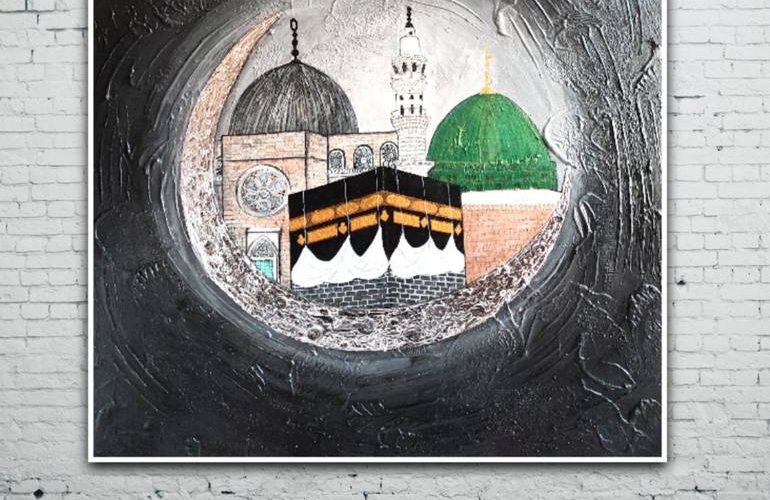Ebrahim Moosa | Palestine Information Network
The blessed land of Bayt al-Maqdis has been a significant region wherein the greatness and brilliance of Sayyiduna Muhammad ﷺ has shone forth.
One of the signs of the coming of Sayyiduna Muhammad ﷺ was that when his mother became pregnant with him, she saw in a dream that a light came out of her that reached al-Shaam.
Sayyiduna Abu Umamah (RA) said: I said: O Prophet of Allah ﷺ, what was the beginning of your affair? He said: “The prayer of my father Ibrahim n and the glad tidings of Isa n. My mother dreamt that there came out of her light by which the palaces of al-Shaam were illuminated.” (Musnad Ahmad)
This vision was physically manifested at the time of his blessed birth when a light did illuminate the palaces of al-Shaam.
The symbolism of the emergence of this light was that the world was going to be filled with guidance and that darkness would be dispelled due to this blessed birth. The particular mention of the palaces of al-Shaam, though, signified that the message of this Prophet would also reach this region, and that in time the domain of Islam would also encompass it.
Ibn Kathir mentions that the fact that al-Shaam was singled out in conjunction with this light indicates that the religion of the Prophet ﷺ and his teachings will abide in Bilad ash-Shaam. Sayyiduna Ka’b h has indicated that the previous scriptures reference that Sayyiduna Rasulullah ﷺ would be born in Makkah, would migrate to Yathrib [Madinah Munawarrah], and that his domain would be in al-Shaam.
In al-Shaam too, the Prophetic light shone when the monk Bahira recognised the impeccable traits of a young Muhammad ﷺ, and perceived how even the elements of nature showed the greatest of reverence to him.
Above all else, the full magnificence of the prestige of Rasulullah ﷺ was to be beheld at Masjid al-Aqsa on the night of Isra and Mi’raj. Here in Bayt al-Maqdis, the heart of Bilad al-Shaam, and the homeland of so many Ambiyaa (AS), Rasulullah ﷺ stood forth as the Imam of the Ambiyaa, and the leader of all the Prophets.
The Ambiyaa (AS) were already assembled at Masjid al-Aqṣa prior to Sayyiduna Muhammad ﷺ arriving. Athaan and Iqamah were called out, and rows for salah were formed in anticipation of an Imam stepping forward. Sayyidua Jibraeel (RA) led Sayyiduna Muhammad ﷺ to be the Imam. Upon the completion of two rak’ahs of congregational Salah, Sayyiduna Muhammad ﷺ was asked if he was aware of who the congregants were. He was informed that he had led a congregation that comprised every single prophet that Allah (SWT) had ever sent to the earth.
What occurred on this night was the practical manifestation of the towering status of Sayyiduna Muhammad ﷺ. Whilst many of the Ambiyaa in the congregation were indigenous to the Holy Land, the choice of Sayyiduna Muhammad ﷺ as Imam, in spite of Bayt al-Maqdis not being his homeland, affirmed his spiritual authority and denoted that al-Aqṣa was now considered part and parcel of his mission’s domain.
The world witnessed on that night at al-Aqsa an illustration of the example provided by Rasulullah ﷺ of his role in relative to those of the previous Ambiyaa: “Verily, the parable of myself and the Prophets before me is that of a man who built a house, perfected it, and beautified it, except for the place of one brick at its cornerstone. The people walk around it and are amazed by it, and they say: Why is this brick not placed? Thus, I am the brick and I am the seal of the Prophets.” (Sahih al-Bukhari and Muslim)
Reminding us of the same light that illuminated al-Shaam at the epoch of his blessed birth, on the night of Isra and Mi’raj, Rasulullah ﷺ related how he saw the angels carrying a white column resembling a pearl. The angels described this as “the Pillar of the Book,” which they said they had been ordered to place in al-Shaam. The ‘Pillar of the Book’ is said to refer to something that acts as a support and that what is referred to here is those who learn the Qurʾān and adhere to it.
The Prophetic light abided in Bayt al-Maqdis through the times of the Righteous Khulafa and Sahabah (RA) who followed in the footsteps of Rasulullah ﷺ and liberated this land, having internalised its sanctity.
There were echoes then too of the luminous Prophetic way at Masjid al-Aqsa on 27 Rajab 583 AH, corresponding to October 2, 1187, when, at a time where the likeliness for exacting vengeance and spilling blood was high, Salah al-Din al-Ayyubi chose magnanimity, echoing the words of Sayyiduna Yusuf n, which were repeated by Rasulullah ﷺ on the occasion of the Conquest of Makkah:
“No reproach will be on you today; Allah will forgive you; and He is The Most Merciful of those who show mercy.” – (Qurʾaan 12:92)
Masjid al-Aqsa today remains a living monument to the truth and greatness of the Beloved of Allah ﷺ through its melodious Athans and Salawat, the dazzling Dome of the Rock from which the Chosen One ascended, and the steadfast character of his followers who defend the faith in the Masjid’s environs.
And the land of gathering and resurrection yearns once again to witness this radiance, when Rasulullah ﷺ will stand forth as the leader of the children of Adam on the Day of Judgement, in his hand bearing the banner of praise.







